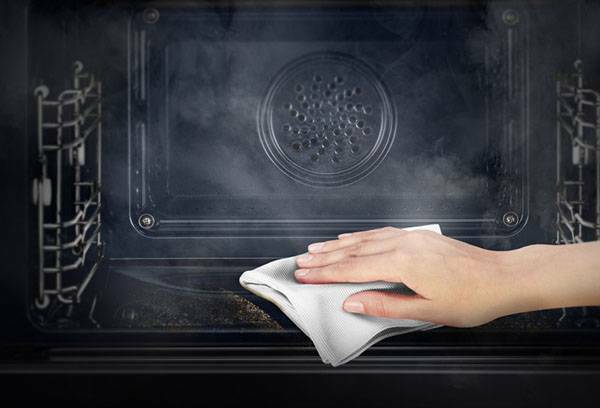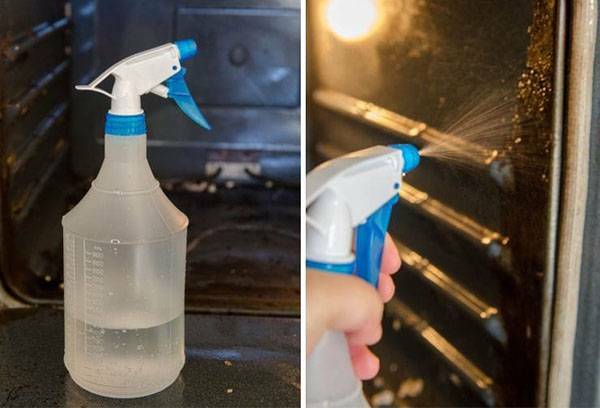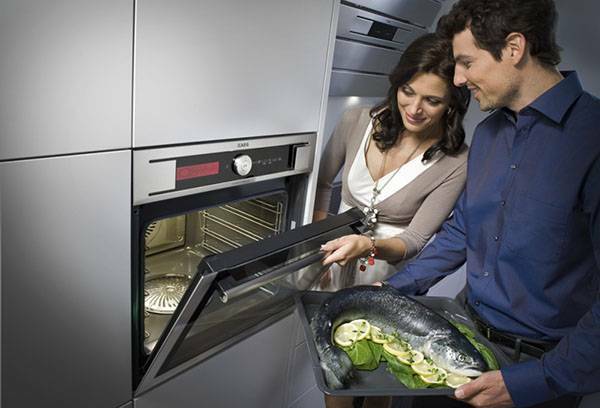Contents:
- Ovens with built-in steam cleaning
- What else can be solutions for cleaning the oven
- What kind of oven cleaning is better - catalytic, pyrolytic or steam?
Perhaps cleaning the oven at home from grease and other contaminants is quite an unpleasant procedure. Fat adheres to the internal surfaces during cooking, so those who like to cook often, such a problem, alas, can not be avoided. In order for the device to last longer, keeping the ideal appearance, it is necessary to periodically remove this fat.
Steam cleaning, or hydrolysis cleaning, is an easy way with which you can remove fat from the inner walls of the oven without resorting to aggressive household chemicals. But you need to know that the method does not guarantee a complete cleansing of fat. Strong pollution can still remain. Steam cleaning only facilitates subsequent washing.
What is hydrolysis cleaning?"Hydro" indicates that water is used in this method. Indeed, in order to clean this way a household appliance, pour water into the baking tray with the addition of a small amount of cleaning agent. After that, the door of the device is closed and the temperature is set at 90-190 degrees Celsius. Water begins to migrate to steam, affecting the fat deposits. It is recommended to use steam when the contaminants in the oven have not dried up yet.
Advice
A cleaner added to water will facilitate easier removal of fat from the walls.

Oven with integrated steam cleaning
In a number of ovens, for example from Samsung, there is a special function "Steam cleaning".What it is? With her, the removal of dirt is done in a similar way.
- First, all household appliances in it are removed from the appliance.
- Then about 400 ml of water is poured onto the bottom of the oven. After that, the door must be tightly covered.
- The "Steam cleaning" function is activated.
- When the cleaning is completed, the device will alert the owner with a beep. After it sounds, you can put the shutdown mode to complete the process.
- After completing all the manipulations, the inside surfaces of the oven are wiped with a cloth. If there is water left on the bottom, then it can be removed with a porous sponge.
- You can leave the door ajar at 15 ° for the enamel to dry completely.
Owners of the oven with the function "Steam cleaning" should also know some rules.
- After opening the appliance door, care must be taken: the water remaining at the bottom of the oven is very hot.
- If the oven gets very dirty, the steam cleaning procedure can be repeated many times.
- It is not recommended to leave water in the oven overnight.
- In case of severe contamination, a detergent may be added to the water.
Household appliances with hydrolysis have some features. So, getting rid of dirt with steam is not recommended to practice regularly. Hydrolysis in combination with cleaning agents can contribute to corrosion of the inside of the oven. However, a number of manufacturers of such devices use enamel, capable of resisting the action of alkalis and acids, when creating their household appliances.
Some models of similar devices have special electronic programs that regulate the time of exposure to steam. In some household appliances, the manufacturer recommends using a special cleaning compound instead of water for hydrolysis. As in the case of water, they also need to fill the tank and turn on the oven. Models with the Cleaning system require the use of special sprays. They replace the effect of steam. Models of household appliances with the Aqua Clean system with hydrolytic cleaning require only 1/2 liter of plain water and 50 degrees Celsius. In just half an hour, the inner surface of such ovens gets rid of dirt.
Curious fact: the same way you can clean the inside of the microwave oven. It is enough to pour the water in a bowl and preheat it for a few minutes.
In some oven models where hydrolysis is provided, the water is not poured into the pan, but into a circular recess provided specifically for this purpose.

What else can be solutions for cleaning the oven
The easiest method for cleaning the oven is to purchase household chemicals that are specifically designed for this purpose. Washing preparations for ovens can be purchased in stores in the department of household chemicals. The cost of such reagents is usually low, but one bottle is enough for a long time. When cleaning with this method it is necessary to know that any contamination is best removed if it is moistened with water beforehand. The lack of use of such means is their too aggressive influence on the inner surface of the oven. In some cases, enamel can be damaged from household chemicals.
Some kitchen ovens use a special self-cleaning enamel. To a similar covering practically do not adhere fatty adjournment. And if something burns, the dirt can easily be removed with a damp cloth without the use of household chemicals. Normally, the pores of such an enamel contain catalyst particles. This contributes to the process of decomposition of fats. This method of purification is called catalytic. A similar method is considered low-temperature, since it is performed when the oven is heated to 140-200 degrees Celsius. To increase the effectiveness of this method, manufacturers propose to install devices with such a cleaning system additionally a filter that absorbs fat.
Another way to clean the appliance is pyrolysis. With pyrolytic cleaning, all the remains of food and fat are burned clean. But this is also the most severe method of cleaning. After its use, only ash remains in the oven chamber. When pyrolysis inside the oven, food and fat burn down at high temperatures. At the same time, the oven door is blocked during the process, so it is impossible to even open it yourself. At high temperatures, the household appliance experiences enormous loads. Such devices are offered by manufacturers Bosch, Gaggenau and others. They provide a level pyrolysis system. Some contaminants, such as food particles, can be burned at 200-300 degrees Celsius, which is why a level system was developed. It allows you to save electricity during the cleaning process.

What kind of oven cleaning is better - catalytic, pyrolytic or steam?
Each cleaning method has its own advantages and disadvantages. Let's consider them separately.
Catalytic cleaning is found in both gas and electric ovens. With this method, fat is removed during cooking, so no additional costs for electrical energy are needed. Such a method of cleaning practically does not require supervision by a person. But catalytic panels eventually become worthless, and they have to be changed. In addition, the ovens with them are not so cheap. Self-cleaning enamel does not cover all the surfaces of the oven, therefore some elements still have to be washed by hand.
Hydrolysis purification occurs at low temperatures. To implement it, do not need a lot of money. This method does not require large power consumption. The most significant drawback of this method is that it does not eliminate all contaminants. Type of cleaning hydrolysis is, rather, an auxiliary method before washing the oven. However, if the particles of food and fat on the inner walls of the oven are not dried, but are in a softened state, then such cleaning will be quite effective.
In pyrolytic cleaning, the oven does not require "analysis" of the components. There is no need to remove the baking tray. The type of pyrolysis purification is the most effective method of getting rid of pollutants. In the oven, where it is provided, special quality materials are used that can withstand high temperatures. However, ovens with pyrolysis are more expensive than others, and pyrolysis can cause an unpleasant smell of burning. Also, in some built-in ovens during this process, the side walls may become very hot.
Each cleaning method has its pros and cons. However, steam cleaning of the oven is the most affordable method and the least expensive. It can be realized in almost any oven. In general, steam cleaning facilitates the care of a household appliance. It can be carried out even without additional cleaning agents.



